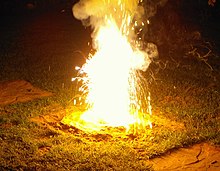Thermite
Thermite is an incendiary mixture. It is not an explosive material, but can burn very fast and very hot.



It is made of an oxide of a less reactive metal mixed with a more reactive metal. One of the most common mixtures is iron(III) oxide-aluminium. The iron(III) oxide oxidizes the aluminium, being reduced to iron in the process. The aluminium is oxidized to aluminium oxide.
Many other metal oxides and metals can be used for thermite. Some metals that can be used are boron, magnesium, calcium, titanium, zinc, or silicon. Some metal oxides that can be used are copper(II) oxide, chromium(III) oxide, iron(II,III) oxide, manganese(IV) oxide, silicon dioxide, boron trioxide, or lead(II,IV) oxide. A metal cannot be used with its metal oxide. The metal has to be more reactive than the metal in the oxide, or the thermite will not work.
Reaction and ignition change
The reaction for an aluminium-iron(III) oxide thermite is this:
- 2 Al + Fe2O3 → Al2O3 + 2 Fe
It is difficult to ignite thermite. It needs to be very hot. Ribbons of magnesium metal are used. A mixture of potassium permanganate and glycerin can be used to ignite thermite. It can be ignited by a flint lighter or a child's sparkler. It can be mixed with sulfur to make thermate, which makes it easier to melt the iron.
Contrary to popular opinion, metals can burn. Common metals need to be powdered, though, or they will conduct the heat away too fast to start a fire.
History change
The thermite (thermit) reaction was discovered in 1893. German chemist Hans Goldschmidt patented it in 1895.[1] People called it the "Goldschmidt reaction" or "Goldschmidt process".[2] Goldschmidt was trying to make very pure metals without the use of carbon in smelting. He soon discovered the value of thermite in welding.[2] It started to be used in the early 1900s to weld train tracks.[3]
Uses change
Thermite is used for its original purpose, welding railroad rails together. It is also used to weld wires. Thermite is also used to make some metals. Chromium can be made by a thermite reaction between chromium(III) oxide and aluminium. The first uranium was made by a thermite. Thermite may also be used in fireworks to ignite other incendiaries.
Thermite was used in the military as an incendiary weapon. It is mainly used to destroy buildings and equipment as it melts the metal easily. Barium nitrate can be added to thermite to make an easier-burning mixture. Especially during World War II, militaries dropped thousands of bombs containing thermite on cities, starting fires everywhere.
Safety change
Thermite is not safe to make at home. It releases ultraviolet light which can damage the eyes. It also makes a very hot flame that can melt iron. It is extremely difficult to extinguish. Streams of molten iron can flow out of a thermite mixture, igniting everything it touches. Some metals can boil and burst into flames when placed in thermite, such as zinc. If it is preheated then ignited, thermite can burn very fast, releasing a huge amount of heat and light. If it is dropped in water it can boil water very fast, making an explosion. Dropping it on ice can make the ice explode, however it is safe to drop it into a three-liter beaker filled with lightly moist sand.
Related pages change
References change
- ↑ H. Goldschmidt, "Verfahren zur Herstellung von Metallen oder Metalloiden oder Legierungen derselben" (Process for the production of metals or metalloids or alloys of the same), Deutsche Reichs Patent no. 96317 (13 March 1895).
- ↑ 2.0 2.1 Goldschmidt, Dr. Hans; Vautin, Claude (1898-06-30). "Aluminium as a Heating and Reducing Agent" (PDF). The Journal of the Society of Chemical Industry. 6 (17): 543–545. Archived from the original (PDF) on 2011-07-15. Retrieved 2011-10-12.
- ↑ "Goldschmidt-Thermit-Group". Goldschmidt-thermit.com. Archived from the original on 2012-04-05. Retrieved 2011-10-12.